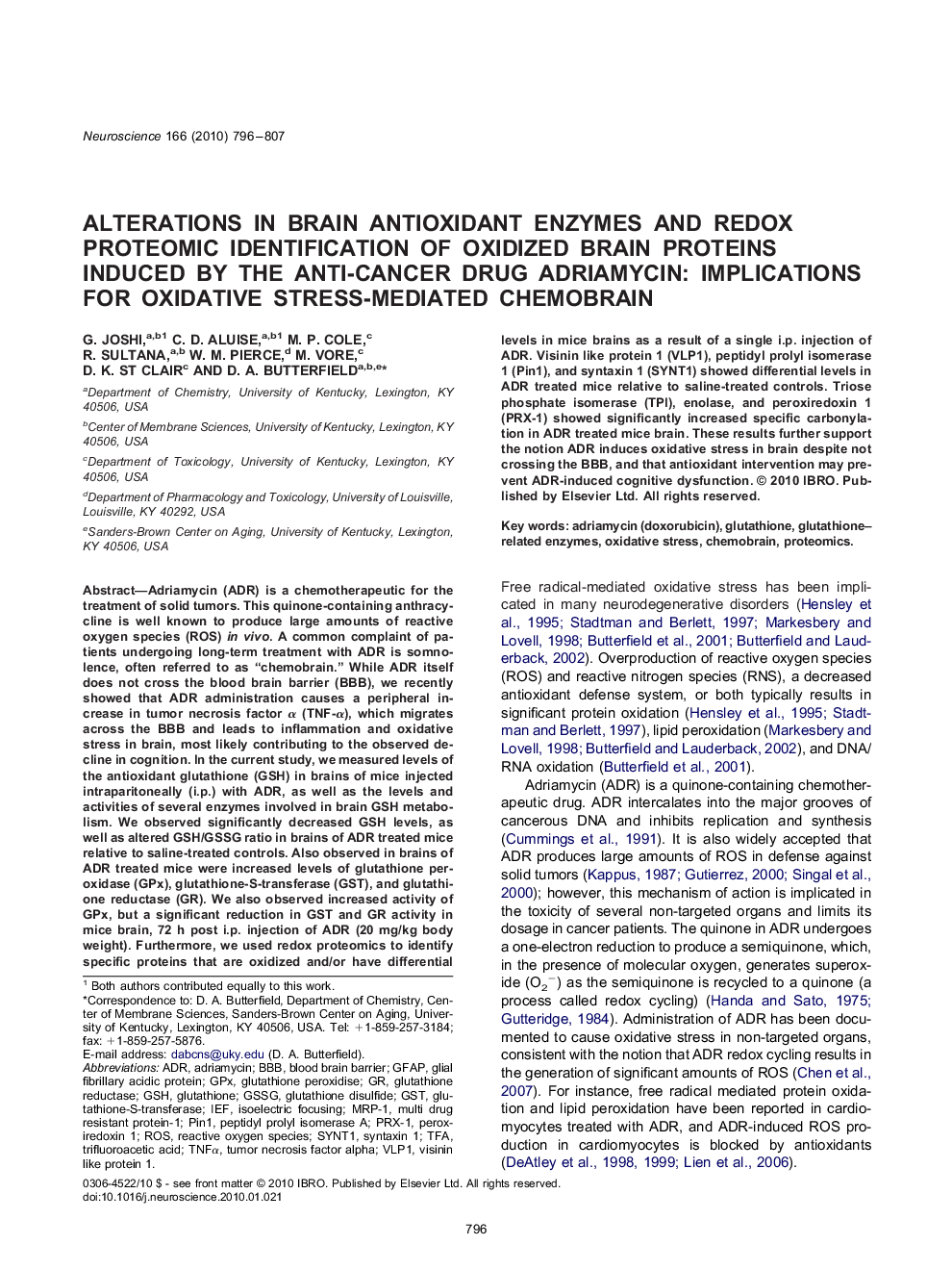| کد مقاله | کد نشریه | سال انتشار | مقاله انگلیسی | نسخه تمام متن |
|---|---|---|---|---|
| 4339512 | 1295758 | 2010 | 12 صفحه PDF | دانلود رایگان |
عنوان انگلیسی مقاله ISI
Alterations in brain antioxidant enzymes and redox proteomic identification of oxidized brain proteins induced by the anti-cancer drug adriamycin: implications for oxidative stress-mediated chemobrain
دانلود مقاله + سفارش ترجمه
دانلود مقاله ISI انگلیسی
رایگان برای ایرانیان
کلمات کلیدی
GPXChemobrainADRMRP-1IEFTFAGSSGGSTGSHGFAPSyntaxin 1TNFαROS - ROSAdriamycin (doxorubicin) - آدریامایسین (دوکسوروبیسین)Adriamycin - آدریانامینTrifluoroacetic acid - اسید Trifluoroaceticisoelectric focusing - تمرکز ذره ای الکتریکیOxidative stress - تنش اکسیداتیوtumor necrosis factor alpha - تومور نکروز عامل آلفاBBB - سد خونی مغزیblood brain barrier - سد خونی مغزیPeroxiredoxin 1 - پراکسیردوکسین 1Proteomics - پروتئومیکسGlial fibrillary acidic protein - پروتئین اسیدی فیبریلاسیون گلایالPin1 - پین 1Glutathione - گلوتاتیونglutathione-S-transferase - گلوتاتیون S-ترانسفرازglutathione disulfide - گلوتاتیون دی سولفیدglutathione reductase - گلوتاتیون ردوکتازGlutathione peroxidise - گلوتاتیون پراکسیدReactive oxygen species - گونههای فعال اکسیژن
موضوعات مرتبط
علوم زیستی و بیوفناوری
علم عصب شناسی
علوم اعصاب (عمومی)
پیش نمایش صفحه اول مقاله

چکیده انگلیسی
Adriamycin (ADR) is a chemotherapeutic for the treatment of solid tumors. This quinone-containing anthracycline is well known to produce large amounts of reactive oxygen species (ROS) in vivo. A common complaint of patients undergoing long-term treatment with ADR is somnolence, often referred to as “chemobrain.” While ADR itself does not cross the blood brain barrier (BBB), we recently showed that ADR administration causes a peripheral increase in tumor necrosis factor α (TNF-α), which migrates across the BBB and leads to inflammation and oxidative stress in brain, most likely contributing to the observed decline in cognition. In the current study, we measured levels of the antioxidant glutathione (GSH) in brains of mice injected intraparitoneally (i.p.) with ADR, as well as the levels and activities of several enzymes involved in brain GSH metabolism. We observed significantly decreased GSH levels, as well as altered GSH/GSSG ratio in brains of ADR treated mice relative to saline-treated controls. Also observed in brains of ADR treated mice were increased levels of glutathione peroxidase (GPx), glutathione-S-transferase (GST), and glutathione reductase (GR). We also observed increased activity of GPx, but a significant reduction in GST and GR activity in mice brain, 72 h post i.p. injection of ADR (20 mg/kg body weight). Furthermore, we used redox proteomics to identify specific proteins that are oxidized and/or have differential levels in mice brains as a result of a single i.p. injection of ADR. Visinin like protein 1 (VLP1), peptidyl prolyl isomerase 1 (Pin1), and syntaxin 1 (SYNT1) showed differential levels in ADR treated mice relative to saline-treated controls. Triose phosphate isomerase (TPI), enolase, and peroxiredoxin 1 (PRX-1) showed significantly increased specific carbonylation in ADR treated mice brain. These results further support the notion ADR induces oxidative stress in brain despite not crossing the BBB, and that antioxidant intervention may prevent ADR-induced cognitive dysfunction.
ناشر
Database: Elsevier - ScienceDirect (ساینس دایرکت)
Journal: Neuroscience - Volume 166, Issue 3, 31 March 2010, Pages 796-807
Journal: Neuroscience - Volume 166, Issue 3, 31 March 2010, Pages 796-807
نویسندگان
G. Joshi, C.D. Aluise, M.P. Cole, R. Sultana, W.M. Pierce, M. Vore, D.K. St Clair, D.A. Butterfield,